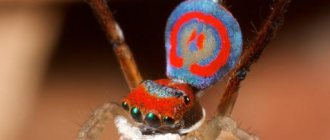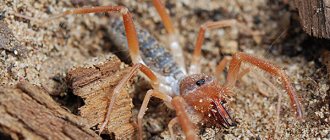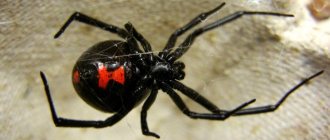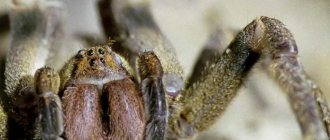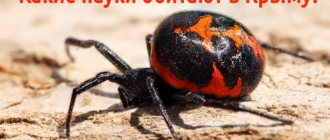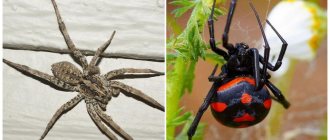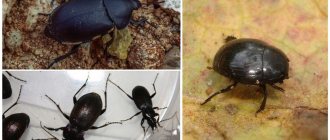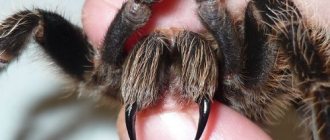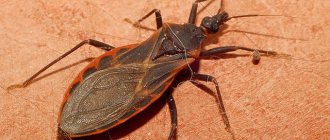Spiders
The unique climatic conditions and landscape characteristics of the Crimean peninsula have made its territory very attractive not only for tourists, but also for many species of arachnids. At the same time, the subtropics of Crimea are a favorable habitat for some poisonous and dangerous arthropods.
Karakurt
Karakurt, a representative of the Black Widow genus, is characterized by a black body color, as well as the presence of red spots in the abdominal area, which sometimes have a white border. Sexually mature individuals can acquire a completely black color with a pronounced shine. The eyes of the karakurt are designed in such a way that spiders of this species have well-developed vision not only during the daytime, but also at night.
Tarantula
Tarantulas are large arachnids from the wolf spider family that live primarily in arid areas. Poisonous araneomorph spiders are characterized by a highly developed sense of smell and a very effective visual apparatus in hunting, providing the tarantula with an excellent 360° view of all surroundings. The average body length of an adult varies between 2-10 cm, and the spider's venom is not fatal to humans.
Argiope Brünnich
The wasp spider belongs to a species of araneomorphic spiders and a fairly large family of orb-weaving spiders. A characteristic distinguishing feature of all representatives of this group was their ability to quickly disperse through webs spreading with rising air currents. Thanks to this biological feature, southern species even inhabit some northern territories.
Solpugi
Camel spiders or wind scorpions have become widespread in dry areas. The body of rather large arachnids, as well as their limbs, are covered with rather long hairs. Mobile nocturnal predators are carnivores or omnivores, feeding on termites and darkling beetles, as well as other small arthropods, but in some cases they eat lizards and other animals.
Argiope lobata
The average-sized spider has an average body length of 12-15 mm. The abdomen is distinguished by a silvery-white color with the presence of six fairly deep recesses-lobules, the color of which can vary from a dark shade to orange tones. The spider's venom does not pose a mortal danger to humans, and the hunting nets of Argiope lobata have a wheel-shaped structure with a densely braided central part.
Steatoda Paikulla
An adult web spider has a black and shiny, spherical abdomen, on the back of which there is a characteristic red pattern. Young specimens are distinguished by the presence of a white pattern in the abdominal area. The average length of a spider's cephalothorax is 0.35 cm, with an average body length of 20 mm. Not too large chelicerae are located in a vertical position.
Black Eresus
The nocturnal arachnid arthropod prefers to settle in beetle burrows and is found in cracks and voids under stones. A spider bite is accompanied by extremely unpleasant sensations, but is not dangerous to human life. The diet is mainly represented by various insects, centipedes, salpugs, scorpions, not too large spiders, as well as woodlice and the youngest, small lizards.
Let's put a cross: biting cross spiders
In many spiders, females are dangerous to humans - they are significantly larger than males (they are simply unable to bite through the skin). This is also true for cross spiders. There are several varieties of them (common Araneus diadematus, diamond-shaped), but they are all similar in habitat, appearance and influence on people.
Krestoviki weave trapping nets and hang them between trees and bush branches. All of them are not rare; many have seen them. A distinctive feature is a light pattern like a cross on the abdomen. These are large spiders - a female, hanging with her legs spread out in the web, can reach 4 cm in “diameter”. They feed on insects.
A cross bite is not dangerous, but can be painful and cause significant local inflammation (up to and including slight necrosis of the tissue around the wound). No special treatment is needed - just lubricate the area with anti-inflammatory agents. If the manifestation is severe, you can take an antiallergen.
This is interesting: Mount Perchem in Sudak (Crimea): photo, how to get there, on the map, description
Phalanx spider or salpuga, habitats. Solpuga in Crimea. Salpuga bites.
Phalanx or salpuga are representatives of arachnids. Outwardly, they are very similar to spiders, but they are not. Salpugs are very interesting insects; their lifestyle combines primitive features and signs of high development. The body of the salpuga is brown-yellow or light brown, 5-7 cm long. The entire phalanx is covered with long hairs. In front there are tentacles-pedipalps, very similar to limbs and performing their function.
Solpuga or phalanx.
Salpugs prefer desert, hot and dry climates, and only a few are found in the loess zone. Phalanges are nocturnal. During the day they hide in the burrows of rodents and other animals; if there is nothing suitable nearby, they can dig it themselves. Most often, salpugs change their home every night, but some can use the same hole for a long time. Although the phalanx is a nocturnal animal, it is very easy to meet it! It is enough to light a big fire and they will come running towards the light.
Phalanxes are predatory animals. They are distinguished by their rare gluttony and promiscuity. They attack everything they can handle and can devour. The salpuga's diet includes spiders, beetles, wood lice, scorpions, and grasshoppers. Large individuals attack lizards and young birds. Scientists conducted an experiment on the unreal gluttony of the phalanx: they placed it in a terrarium and threw all kinds of delicacies there. The phalanx pounced on the offered food and ate until its belly burst! Even after this, the salpuga continued to eat until she died.. Such a voracious creature!
Due to the structure of the body, the salpuga is very mobile and maneuverable. Some individuals can jump up to 1 meter in height and reach speeds of up to 16 km/h. Thanks to this feature, they received one of their names - “wind scorpion”, which is translated as “wind scorpion”.
Salpuga (phalanx) bites.
Small individuals are not able to bite through human skin, but large phalanges can do this. Salpugs do not have glands that produce poison, and the bite itself is not poisonous, but particles of previous victims remain on their jaws, decomposing and rotting. These residues are very toxic and, if they enter an open wound from a phalanx bite, can cause both local inflammation and blood poisoning. The bite itself is very painful and unpleasant, even without consequences.
The bite site must be thoroughly treated with brilliant green or peroxide and a clean bandage or plaster applied. Under the bottom you can put a little antibiotic gel, for example levomekol. Change the bandage daily and treat the wound until complete recovery.
Solpuga - an inhabitant of the southern coast
Salpugs, also known as phalanges, are another interesting species of spider in Crimea, listed in the Red Book. They live in arid areas, mainly in the foothills of the southern part of the peninsula. They are active at night. The body length can reach 5-7 cm. The entire body and paws are covered with hairs. The forelimbs resemble tentacles. They feed on insects, small lizards, and scorpions. The structure of compound eyes, which provide instant reaction and visibility in the dark, makes salpugs excellent hunters.
Salpugs are very mobile, run well and even jump high
In South Africa, such arachnids are called barbers. This name stuck due to the developed strong front tentacles, through which they are able to deprive a person of hair on his head, as well as animal hair. Spiders line the bottom of their nests with “cut” hair.
Small individuals cannot harm humans, since not yet fully formed chelicerae are not able to bite through the skin. But a meeting with an adult spider does not bode well. Their chelicerae are equipped with teeth and their bites are very painful. And although the spider does not inject venom when it bites, its jaws retain the remains of previous victims, which can penetrate the wound and cause rotting. It is noteworthy that salpugs are not afraid of people and can easily join gatherings near the fire.
Harmless
The following families are very common in Belarus: funnelbirds, hunters, sidewalkers and horses. Besides them, you can find 4 species of wolf spiders there. Apart from family and protective coloration, these night hunters have nothing in common with the South Russian tarantula, which is also a wolf spider.
Funnel
Funnelfish live in moist, shaded places, on the forest floor, under snags and at the foot of bushes. They often settle in village houses. People gravitate toward human habitation:
- funeral;
- brownies;
- attics.
Hunters
They live on the banks of reservoirs, of which there are plenty in Belarus. There are only 3 pisaurid spiders found in the country. Spiders hunt with their hind legs on coastal vegetation and their front legs on the water surface. These hunting spiders can glide across the surface of a body of water like water striders.
Horses and sidewalkers
Jumping and side-walking spiders are inhabitants of meadows, forest clearings and agricultural fields. Most often, these arthropods sit in ambush on grass or leaves of bushes. They catch small insects that fall within their reach. These small animals pose no danger to humans.
The most unusual species
Nature sometimes puts spiders in such bizarre forms that you just wonder where so much imagination comes from. Here are just a few such examples.
- Spider-Peacock. It is distinguished primarily by its bright color, reminiscent of a peacock feather. The size of the individual is limited to five millimeters, so it is not easy to see. Only males have this color.
- Crab spider. Externally it resembles a crab. In addition, this unique creature can move, just like a crab, from side to side and back to front. And the ability to change color makes it invisible against the background of its habitat.
- Dolomedes. Another name for this spider is “fish”, since it lives near bodies of water and feeds on small fish, which are no larger in size than itself.
- Spider is a whip. This creature rather resembles a thin twig and is completely unlike its fellows. The species was named Colubrinus, which means serpentine. Nature created it this way for camouflage. Such a predator sits in the web, and the prey thinks that the twigs are stuck to the web and is not afraid of it at all.
Karakurt - a poisonous inhabitant of Crimea
The karakurt is recognized as the most dangerous representative of spiders. It feeds on insects. Favorite habitats are rodent burrows, from which the spider easily expels the inhabitants. Even if the mouse decides to resist the karakurt, it instantly dies from its bite. Also settles between stones, in rock cracks. It places its trapping nets in the grass, in the steppes and even in summer cottages. From Turkic the name “karakurt” is literally translated as “black worm”; a photo of the dangerous spider of Crimea is presented above.
What does the most dangerous spider in Crimea look like:
- Sexually mature females are rich black in color with a glossy sheen, up to 2 cm long.
- The length of males does not exceed 7-8 mm.
- Juveniles and males have 13 red spots on the abdomen. Sometimes they are framed with a white border.
- Two pairs of eyes help to navigate well during the day and at night.
- Random networks are located mainly near the ground.
Karakurts are very prolific. Periodically, at intervals of 10-12 or 25 years, there is a massive outbreak of population growth. They spend winter time in cocoons, several of which are suspended in nests. In mid-spring, the young generation appears and is carried away on the web by the wind. At the end of June, having become sexually mature, females and males look for shaded places and weave nets for mating.
Interesting! Due to the bloodthirstiness of the female during mating, the karakurt is also called a black widow. The mating games of the female are very peculiar - at the end of the process, she eats the male. The female has an excellent appetite: her network for mating can simultaneously contain up to 5 candidates.
The males' life cycle ends in mid-July. After mating, females look for new places, weave a network and lay offspring. After the last laying of eggs they die.
How karakurts bite
Representatives of the black widow genus are not characterized by aggressiveness towards humans. Only if they sense danger do they defend their lair - only in emergency cases are they able to attack people. Most often, this type of spider in Crimea bites accidentally. This is due to the peculiarity of their reflexes. When pressed on the abdomen, they release poison; for this reason, a spider crawling on the body should not be slammed, but carefully thrown off.
The greatest threat to humans is the female karakurt, while males, due to their small size, are not able to bite through human skin
On a note! After picnics or trips to nature, it is recommended to inspect things, as spiders can easily get into them. It is best to walk through thickets of grass in closed high shoes, and to work in summer cottages and fields with gloves.
The concentration of poisonous components in karakurts is 15 times higher than in a rattlesnake. This feature is due to the fact that spiders wage a constant fight against rodents and other small mammals, and to neutralize them a strong poison is needed. In humans, the probability of death after a bite is 2-4%. The poison has a neuroparalytic effect.
Symptoms of a karakurt bite:
- the appearance of severe burning pain, which intensifies and spreads throughout the body within 15 minutes;
- difficulty breathing;
- dizziness, possible bluish discoloration of the skin on the face;
- disturbances of heart rhythm and kidney function;
- cramps, muscle spasms in the abdominal area;
- depressive state, the appearance of a feeling of irresistible melancholy and fear of death.
On a note! The sensations of the bite field depend on the person’s pain threshold. There are cases when people in a dream did not notice at all that they had been bitten by a spider.
What to do if you are bitten by a karakurt:
- The most effective way to eliminate the consequences of a bite from the most dangerous spider in Crimea is to administer a serum. However, it is not always available at medical centers. In its absence, an intravenous injection of potassium manganese or calcium gluconate is administered. The need for a second injection is determined by the condition of the victim.
- In the field, the cauterization method, which was developed by Marikovsky, is used. Immediately after the bite, in order to neutralize the effect of the poison, 3 matches are applied to the wound (heads to the wound), and the fourth is set on fire. High temperature destroys the protein structure of the poison and thereby avoids poisoning the body.
"Relationship" with a person
Although the spider with yellow stripes on its back is classified as poisonous, it does not pose a great danger to humans. Firstly, he is afraid of people and will never attack first; rather, he will run away or fall to the ground and pretend to be dead. Secondly, argiope is not able to bite through human skin to inject poison.
But if you take a wasp spider with your bare hand, an unpleasant and rather painful bite is guaranteed. The redness and itching of the stung area goes away quite quickly. For allergy sufferers, the reaction can be more violent and unpredictable - from severe swelling of the bite site to increased temperature and swelling of the respiratory tract.
Therefore, it is better to stay away from the beautiful and insidious arthropod. It has no place at all in the garden or flower garden. But if you meet him in the forest, let him live!
Video about the wasp spider:
The black fathead is sometimes called the ladybug spider. It really resembles this bright insect: against the red or orange background of its abdomen, four black spots with a white border stand out.
However, only the male looks so impressive. The female black fathead, although larger, is less brightly colored. It is usually velvety black, sometimes with yellow elements on the front.
Scorpion
An endemic species of scorpion lives in Crimea. It is very small, only 35-40 mm long. The color is light yellow, the claws are brownish. Meeting him is a great rarity and, rather, luck than misfortune. After all, its bite is not fatal. True, it causes poisoning of the body. When bitten, a very strong pain is felt, the place immediately swells. Weakness of the body, decreased pulse rate, and sometimes headache, vomiting, and suffocation may occur. In this case, you need to take anti-allergy tablets and treat the bite site with vinegar or fresh tomato. Doctors say that after these measures, in principle, you can do without their services.
By the way
Snake and insect experts say that when a person is bitten by any animal, the main enemy is not poison, but panic. It is this that, firstly, prevents a person from assessing the situation and taking the first measures, and secondly, panic helps make already unpleasant symptoms seem twice as painful and scary. Many, for example, lose consciousness not so much from the bite itself as from horror. Therefore, experts advise, paradoxical as it may sound, not to panic: after all, a fatal result for our latitudes is very rare.
Do you know that…
According to the Guinness Book of Records, the Brazilian wandering spider is considered the most poisonous spider in the world. This spider got its name because it does not sit in one place and does not weave webs, but actively moves in search of food. It eats insects, other spiders, birds and lizards, and is also very fond of bananas.
Some specimens of this spider are so dangerous that human death can occur within 20-30 minutes if immediate help is not provided.
Why is a karakurt bite dangerous?
The neurotoxic venom begins to act almost at the moment of the bite. In this case, the place where the skin is damaged and the poison enters the body quickly turns red and hurts. As a result of damage to the nervous system, severe muscle pain appears. It starts with the calf and abdominal muscles. After 10–20 minutes it covers the entire body. After this, severe dizziness develops, breathing becomes difficult, profuse sweating, trembling, shortness of breath, nausea, etc. occur. If medical assistance is delayed, the condition is aggravated by mental reactions, such as depression or painful agitation. In especially severe cases, clouding of consciousness and delirium occurs. Antikarakurt serum is required for treatment. However, there are other drug treatments for black widow poisoning, but they are less effective.
It's not just people who die from black widow bites. They are especially dangerous for camels, horses and cows. Sheep, goats and pigs are practically not affected by spider venom.
Attention, black widow
“Black Widow” is the name of the American variety of this spider. But the Crimean one is no better. The name explains not so much the female’s habit of snacking on her husband after mating (many varieties of arachnids do this), but rather the real danger to humans.
Karakurt (Latrodectus tridecimguttatus) is the scientific name of this creature. Translated: “black worm.” You should only be afraid of spiders - the males are small, often cannot bite through the cover, and they have little poison. The female is an awkward-looking creature with a body up to 2 cm long, and the lion’s share falls on a black abdomen with or without bright red spots. The remaining parts of the spider are pure black, glossy. It lives in burrows and places its nets low above the ground.
Karakurts are the most poisonous spiders living in Crimea. Their poison is similar to that of rattlers, only 15 times stronger. The mortality rate is, of course, lower - the dose is not the same. But after the bite the following appear:
- pain (in the affected area and throughout the body);
- convulsive conditions;
- heartbeat disturbances;
- difficulty breathing;
- disorders of the kidneys;
- dizziness;
- cyanosis (blueness of the face);
- depression, panic attacks;
- abdominal cramps.
You cannot self-medicate if you are stung by a karakurt - rush to the doctor as quickly as possible. The optimal treatment option is the introduction of a special serum (produced only in Uzbekistan, costs about $1,000 per dose). If it doesn’t turn out to be there, Crimean doctors know alternative options.
Many people are also afraid of salpugs - these are scary light (sometimes white) creatures with huge jaws. You should be afraid of them, but the salpuga is not a spider, but a phalanx (something between spiders and). But in general, you need to carefully look around and always have at least diazolin with you, and better yet, diphenhydramine. We hope that our article will help you avoid troubles associated with poisonous spiders in Crimea. In conclusion - an interesting video, enjoy watching!
Poisonous spiders of Russia. There are few of them, but they exist! It’s better to know these dangerous “comrades” by sight!
Russia is a country of limitless diversity of flora and fauna. Just imagine: our country is home to about 1070 species, 40 varieties and 30 families of spiders alone! But, unfortunately, no matter how beautiful and unusual they are, not all spiders in Russia are safe for humans. What arthropods should you be wary of, and what should you do if a dangerous encounter could not be avoided?
The most dangerous spider that lives in our homeland is the karakurt. It is also called the steppe spider or. The animal looks quite bizarre: the deep black body is decorated with thirty bright red dots on the upper side of the abdomen. As the spider matures, the spots disappear and the body acquires a rich black color with a characteristic shine. Karakurt can be found in the Crimea, in the south of the Urals, in the Moscow region and in the North Caucasus.
The bite of this arthropod causes unbearable pain throughout the body, causes severe poisoning, which, if not treated correctly, can lead to the death of the victim. The most dangerous are female karakurts.
What to do if a bite occurs? Within a few minutes, you need to cauterize the affected area with two or three matches. As soon as possible, the victim must be taken to the hospital, where he will stay for a couple of days.
Next in our ranking of dangerous spiders is the South Russian tarantula, which is also called the Mizgir. This animal has a furry body, up to 30 mm long. Its abdomen is brownish-red in color, and its body is darker in color. They live in the steppe and semi-desert territories of our country; they have been spotted in the Saratov, Oryol and other regions. Tarantulas have a black cap, which distinguishes them from other representatives of the dangerous animal world. The bite of these animals is not fatal, but causes a complex allergic reaction.
Another representative of poisonous spiders in Russia is the eight-legged Cheiracanthium. This spider is quite peaceful and bites only in defense. It has an oblong body of light yellow color. The place of residence of this arthropod is the North Caucasus, but it can also be found in other parts of our country.
The least dangerous, but also poisonous, are web spiders. They belong to the subspecies of crosses. They got their name due to the cross-like pattern on their abdomen. Networts are members of the orb weaver family; their webs are large and radial. The body of these animals is relatively small (no more than 25 mm in length) and has different shades. Like Cheiracanthiums, networts attack only if they are threatened. An arthropod's bite can cause an infection, so if necessary, consult a doctor.
Black and green spiders, not dangerous to humans
Considering the types and names of spiders that do not cause any harm to humans, we decided to focus on the following families:
- brownies;
- crosses;
- horses;
- side walkers.
The brownie is a forest spider that has been living in human homes for many hundreds of years. These yellow-brown individuals feed on domestic insects, so they can be called apartment orderlies. Of course, the very presence of spiders with a skull on their back does not really advertise the cleanliness of their owners. On the other hand, there is a popular belief that a brownie is a sign of financial well-being.
The cross spider is a black spider with white stripes on its back, forming something like a cross. Often the spots are rather yellowish. The males of these black and white spiders are much smaller than the females. They have the ability to weave large nets and a strong appetite. In one sitting, an individual can eat up to eight insects. For humans, a spider with white spots on its back is completely safe. The maximum harm from them is a slight burning sensation for a short time.
The jumper is a black spider with white stripes, which, however, can have almost any color. The special structure of the body and legs, as well as a well-developed internal hydraulic system, allow it to jump long distances and climb vertical smooth surfaces. Such a spider with a red belly is the worst nightmare of many insects. The horse can weave a cocoon from silk thread for the “maternity hospital” of its female. Perhaps the only one of all spider species that does not eat its own kind. Such nobility deserves special mention.
The sidewalker is a spider with a green back that can change colors depending on the circumstances. For the active hunter that he is, this is a big help. Just now there was a very noticeable spider with a white belly - suddenly it disappeared. Where? Take a closer look and you can barely make out a spider with a green abdomen among the plants. And so on. This white-backed spider, which can turn yellow when necessary, got its name because of the way it moves. Outwardly, it resembles the gait of a crab.
Regardless of who bit you - a poisonous tarantula or a harmless spider with black and white legs - you should immediately disinfect the affected area of skin. If an accident occurs in nature and a person immediately becomes ill, you need to see a doctor as soon as possible. In such cases, the alarm is never false. You can get more interesting information about the modern classification of spiders on the website of our company in Moscow.
I think these creatures could easily destroy the entire population of our planet. They are smart, cunning, resourceful and incredibly poisonous. Having a large number of limbs, unlike humans, these creatures are able to move faster. They are also able to weave skillful traps into which each of us fell. But such seemingly perfect plans to take over the world fall apart due to their size. Nature decided that they should be no larger than a human palm.
Can you guess who we'll be talking about in this top?
That's right, about spiders. Quite dangerous creatures, aren't they? People are very lucky that these creatures are so small in size. After all, even if they were at least the size of an ordinary cat, I think there are few who would remain on earth now except these poisonous arthropods.
Spiders were even defined as a separate class based on phenotype. However, their almost unique properties, I think, also deserve this separate group.
Now let’s prove our thoughts with facts. Top 10 most dangerous and poisonous spiders on the planet!
It is also called golden or golden, although judging by the consequences of meeting it, it is not such a “golden” spider. He lives mainly in Europe. Its size is very small, up to one centimeter in length. These arthropods build their houses like a bag, elongated like a pipe. Sometimes they can hide inside the house. Very often their bites are misdiagnosed - they are mistaken for the bite of a brownish recluse spider. These bites are always clinically dangerous. After them, severe pain appears and a necrotic wound develops, of course not as quickly as in a recluse spider. A yellow spider may bite only because it senses danger. Therefore, if you are planning a trip to European countries, be sure to remember what the Poisonous Spider Sak looks like, and do not anger him when you meet him.
What is the situation with spiders in Krasnodar
Environmentalists note that the climate is gradually changing. Spiders that previously lived in Crimea began to appear in the Krasnodar Territory. Thus, in the summer of 2015 alone, 3 bites of poisonous insects were registered that had not previously settled in the surrounding areas.
Patients noted that they were bitten by a spider that they had not seen before. Immediately after the attack, the victims developed symptoms of allergies and body intoxication. This forced people to immediately seek help from doctors.
Every year the number of “foreign” insects is rapidly increasing. Doctors say spiders are often not the first to attack
This is why it is important to be careful and inspect shoes and clothing before putting them on.
Recently, sak has appeared in the Krasnodar region. Previously, this spider lived only in Germany and Australia. Poisonous, but not lethal.
If you want to know more about poisonous spiders in Russia, then watch this video:
Source
How to protect yourself while hiking. Simple rules
Be especially careful in the evening and at night, when arthropods are most active. Try to walk in closed shoes. When collecting wood for a fire, first turn over branches or sticks with your feet to make sure that no one is under them.
Boots.
Try not to leave your boots outside the tent overnight.
If you don't feel comfortable with them in your tent, hang them from a tree or tuck a sock into the top. Be sure to shake them out in the morning. Tent.
Treat the entrance to the tent with repellent.
At any time of the day, the entrance to the tent must be closed with a zipper. Sleeping bag.
Before going to bed, shake out your sleeping bag.
Cloth.
If clothes have been left outside for some time, it is also a good idea to shake them out.
Medicines.
Carry with you in case of an allergic reaction from a bite.
Now you know about all the potentially dangerous inhabitants of Crimea
If reasonable precautions are taken, the risk of threat to life and health is minimal
Do not forget that the most poisonous on the Crimean peninsula is karakurt, the poison of which is several times stronger than the poison of a rattlesnake. The bite of other arachnids in Crimea is not fatal and does not pose a serious danger to a healthy person, but allergy sufferers, children and people with weakened immune systems remain at risk.
Emergency care for snake bites and farts. Video from Dr. Komarovsky
The unique climate and landscape of the Crimean peninsula has always attracted tourists. Some people prefer to relax in comfortable rooms and only occasionally go on walks to explore the surrounding area. Others, like the heroes of the film “Three Plus Two,” blithely climb away from civilization and enjoy sandy beaches, mountain landscapes or steppe expanses around the clock. However, not everyone knows that the spiders of Crimea can pose a serious threat to humans and getting to know them can end very badly, even leading to death.
Arachnids
The arid regions of Central Asia and Africa are home to large arthropods that are often mistaken for spiders. These are salpugs. According to the tracing paper from English, they are also called. But unlike spiders, salpugs have teeth, they do not have arachnoid glands and are not poisonous.
Salpuga is a large animal capable of catching up and killing not only invertebrates, but also small lizards. The chelicerae of large salpugs are so powerful that they can bite through a human fingernail. No real spider is capable of this. Although salpugs do not have poison, their bite can be very dangerous. Particles of decaying flesh remain on the chelicerae of these arthropods. After a bite you can get blood poisoning.
Spiders cause many problems, although they are one of the most harmless and useful inhabitants of the planet. Spider lovers consider them “kittens.”
The wealth of species in the wild is simply staggering. There are over 35 thousand species of arachnids alone.
And in this article we will look at one of the amazing subspecies, allegedly similar to a wasp - Argiope bruennichi.
Read on to learn about the features of appearance, habitat, lifestyle, methods of weaving webs, reproduction, danger to humans and the possibility of keeping them at home.
Destructive flora: dangerous plants of Crimea
Is it dangerous to walk through the forests of Crimea? To a certain extent, yes, because on a walk you may come across beautiful and attractive plants that are considered poisonous.
Crow's eye. A toxic plant, but its dark blue berries, similar to blueberries, are especially poisonous. If you eat such “beauty”, then severe poisoning is guaranteed.
Crow's eye is a poisonous plant, the fruits of which can be confused by both children and adults with blueberries.
Yasenets (Burning Bush, Asterisk). The lilac or pink flowers of this plant cause severe skin burns within a few hours of touching it. The ash tree is not dangerous to the body, but after it heals, scars remain. Grows in all forests of Crimea.
Ash tree has a pleasant citrus aroma, but even inhaling the pollen of this plant can cause a burn to the respiratory organs.
Aconite (wolf root, king potion). The plant with blue flowers grows in beech forests and is considered completely poisonous. Affects the central nervous system, causing convulsions and paralysis of the respiratory organs.
Aconite is unknowingly used to brew tea, which leads to severe headaches and hallucinations.
Belladonna. A plant with a purple fruit like a small cherry. If you eat it, it begins to burn in your mouth, it becomes difficult to swallow, your heart rate increases, and hallucinations are possible. If a person is not helped in time, the outcome can be very unfavorable.
Belladonna berries, which look appetizing in appearance, taste like cherries, which is why children are often poisoned by this plant.
Bollygolov. Looks like a parsley bush in the flowering stage. Both the leaves and fruits of this plant are dangerous - they paralyze muscles, legs, and the skin loses sensitivity. Respiratory paralysis is especially dangerous.
Hemlock venom can cause food poisoning, convulsions, and paralysis.
First aid for poisoning by poisonous plants
: induce vomiting to cleanse the stomach, take activated charcoal, an antipyretic. In the case of black eye, vomiting cannot be induced; only the use of activated carbon is recommended. In the case of plants that cause skin burns, wash the affected area with soap and use anti-burn ointment.
When to see a doctor
- a child or a person weakened by illness is bitten;
- the state of health of the bitten person deteriorates sharply;
- an allergic reaction began: severe pain and swelling, a rash around the bite site.
Experienced tourists, when bitten by a tarantula while hiking, take a break for several hours, when the symptoms are most severe, and then continue the hike. But these are people who are already familiar with the spider and are ready for all sorts of consequences. It's better to go to the hospital.
There are millions of people in the world who suffer from arachnophobia, that is, the fear of arachnids. And their fears are not groundless: although most of them are completely or relatively safe for humans, among them there are those that threaten life. Spiders of Crimea do not graze their hind legs - in the fauna of the peninsula there are a number of poisonous representatives of eight-legged species, which we will talk about today.
Argiope
A genus of spiders up to 1.5 cm in size with a yellow-black color, for which they are sometimes popularly called “wasp spiders.” Spiders weave trapping webs at dusk; construction takes about an hour.
Argiopes are one of those spiders whose females eat their male.
Argiope's venom is not fatal to humans, but a bite can cause a lot of trouble. The worst of them is an allergic reaction to the components of the poison. In most cases, the consequences of a bite are abscesses, but in some cases tissue necrosis may develop.
Source
Steatodes Scientific classification intermediate ranksDomain:EukaryotesKingdom:AnimalsSubkingdom:EumetazoansNo rank:Bilaterally symmetricalWithout…
Tarantula in Crimea: a serious matter
The South Russian tarantula (Licosa singoriensis) was recorded in Crimea only in recent years, but during this time it managed to become trivial on the peninsula and cause a lot of trouble. He is a burrowing, steppe animal, lives in dry areas (in the area), where there is vegetation, and digs holes in the ground (or engages in hostile seizures of mice, and kills the owners). The spider does not weave webs - it waits in the hole for the prey to approach, and then with a sharp throw it pounces on it and paralyzes it with its bite. Spiderlings that hunt in this way are called “wolves.”
They are gray in color, shaggy - this can be seen if you look closely, with powerful legs. Yes, these are the largest spiders in Crimea. Their body length sometimes reaches up to 3 cm, with outstretched legs twice as long, but they rarely take this position. The females guarding the cocoons are especially dangerous (they look exactly like cocoons, only with a rather non-standard weave). They often climb into the tents of inattentive tourists.
Tarantulas are dangerous animals. In Italy and Spain in the Middle Ages, it was believed that the only way to survive after their bite was to dance a grueling dance for a long time (yes, this is how the famous tarantella appeared). In fact, it is quite difficult to die (although it is possible with an enhanced reaction). But significant pain, swollen lymph nodes, nausea, rapid heartbeat, fever and difficulty breathing are traditional.
The victim is advised to drink plenty of fluids and take an antihistamine (the sooner the better). Immediately after contact, the wound can be cauterized (with gray from a match head). A spider is not a snake; it pierces the human body only a couple of millimeters, so the procedure will be both effective and not too painful. But tourniquets cannot be applied. If the reaction turns out to be pronounced, you need to fly to the doctor at full speed. Patients with allergies to a tarantula bite can die from cardiac arrest or suffocation.
Types of spiders, names and photographs
Scientists have described more than 42,000 species of spiders. About 2,900 varieties are known in the CIS countries. Let's consider several varieties:
Blue-green tarantula (Chromatopelma cyaneopubescens)
one of the most spectacular and beautifully colored spiders. The tarantula's abdomen is red-orange, its limbs are bright blue, and its carapace is green. The size of the tarantula is 6-7 cm, with a leg span of up to 15 cm. The spider’s homeland is Venezuela, but this spider is found in Asian countries and on the African continent.
Despite belonging to tarantulas, this type of spider does not bite, but only throws special hairs located on the abdomen, and only in case of severe danger.
The hairs are not dangerous for humans, but they cause minor burns on the skin, similar in effect to nettle burns. Surprisingly, female chromatopelma are long-lived compared to males: the lifespan of a female spider is 10-12 years, while males live only 2-3 years.
Flower spider (Misumena vatia)
Belongs to the family of side-walking spiders (Thomisidae). Color varies from completely white to bright lemon, pink or greenish. Male spiders are small, 4-5 mm long, females reach sizes of 1-1.2 cm.
The species of flower spiders is distributed throughout European territory (excluding Iceland), and is found in the USA, Japan, and Alaska. The spider lives in open areas with an abundance of flowering herbs, as it feeds on the juices of butterflies and bees caught in its “embraces.”
Grammostola Pulchra
A species of tarantula spider that naturally lives only in Uruguay and the southern regions of Brazil. A rather massive spider, reaching a size of 8-11 cm, with a dark color and a characteristic “metallic” sheen of hairs.
In nature, it prefers to live among the roots of plants, but almost never digs its own burrows. Pulhra often becomes a pet among connoisseurs of exotic pets.
Argiope bruennichi or spider wasp (Argiope bruennichi)
A spider with an unusual coloring of the body and limbs - yellow, black and white stripes, for which it received its name. True, the male wasp spiders are not so bright, and they are smaller in size than the females: the “young ladies” reach a size of 2.5 cm, and together with the legs - 4 cm, but the male rarely grows more than 7 mm in length.
The species is widespread in Europe, Asia and southern Russia, the Volga region and North Africa. The Argiope spider lives in meadows with an abundance of grass, on the edges of forests. The web of the argiope is very strong, so it is difficult to tear it, it will only stretch under pressure.
Apulian tarantula (Lycosa tarantula)
a species of spider belonging to the wolf spider family (lat. Lycosidae). It lives in the vast expanses of Southern Europe: it is often found in Italy and Spain, and digs burrows half a meter deep in Portugal. The size of the tarantula is impressive - up to 7 cm in length, individuals are usually colored red, less often - brown, the body has several light-colored transverse stripes and one longitudinal one.
Black widow (Latrodectus mactans)
This is a very dangerous and poisonous species of spider. It lives in Australia, North America, and is also found in Russia. The size of females reaches 1 cm, males are much smaller. The body of the black widow is black, and on the abdomen there is a characteristic red spot in the shape of an hourglass. Males are brown with white stripes. A black widow's bite is deadly.
Tarantula. Crimean tarantula. Tarantula bite, help with a bite.
is the common name for several species of large spiders belonging to the wolf spider family. Tarantula is an invertebrate animal. Its body, consisting of two parts - the cephalothorax and abdomen, is covered with small hairs. Tarantulas are the largest spiders living in Ukraine, the size of large individuals reaches 4 cm. The spider is colored brown-gray-black, and those that have not shed for a long time have a red tint. Very often, other large spiders, such as tarantulas, are mistakenly called “tarantulas.”
Crimean tarantula. Tarantula habitat.
The name tarantula comes from the Italian city of Tarantum. People in the Middle Ages believed that anyone bitten by a spider would become ill with a terrible disease - tarantism. It was expressed by complete indifference to everything and always ended in death. The only means of salvation was the wild dance of the tarantella. To get rid of the disease, you had to dance until you were completely exhausted.
Tarantulas love dry areas such as steppes or deserts. In Ukraine, the tarantula is found in the steppe part of Crimea. Tarantulas are nocturnal predators. During the day, they take refuge in vertical burrows up to 50 cm deep. Sometimes they choose natural shelters for shelter - various cracks and faults. To protect themselves from frost in winter, tarantulas deepen their burrow and bury the entrance.
At night, spiders come to the surface and begin hunting. The tarantula's diet consists of various insects, smaller in size than the spider itself. Tarantulas do not weave trapping nets; they use the web only to build an egg cocoon and cover the walls of the burrow.
Tarantula bite.
All tarantulas are poisonous, but this does not mean that they are particularly dangerous to humans.
Their venom is enough to paralyze a small animal, but for people a tarantula bite is equivalent to a wasp sting, well, maybe a little stronger. Swelling appears at the site of the bite, the venom causes pain and numbness, and the temperature often rises. Only a severe allergic reaction can lead to death.
Tarantulas never attack anything larger than themselves. And from this it follows that he will not bite a person first, only in case of self-defense, for example, when you accidentally pressed him.
First aid for a tarantula bite.
- Wash the bite area thoroughly with plenty of soapy water.
- Apply a tourniquet to the bitten limb and immobilize it as much as possible.
- Apply ice to the bite site.
- Drinking plenty of fluids is recommended. Then some of the poison will be eliminated faster in the urine.
- For adults, you can give aspirin or acetaminophen. It is better to give paracetamol to children.
- If possible, crush the tarantula and apply blood to the bite area. The fact is that his blood contains an antidote to his own poison.
- If an allergic reaction occurs, it is better to take the victim to the hospital as soon as possible.
Photo of the tarantula:
Externally, in our usual understanding, local spiders are similar to: karakurt, tarantula, agriope and salpuga (phalanx). But! There are also other dangerous arachnids here - ticks and even the Crimean scorpion - yes, all this is one class of arachnids. The ringed scolopendra is also found in Crimea. Stinging insects include the hornet, wasp, gadfly and the ubiquitous mosquitoes.
A beautiful but not dangerous spider of the Crimea, agriope
The Agryope spider lives in Crimea. In size it is comparable to a cross. Many consider it very beautiful, since this spider is characterized by a peculiar black and yellow color. This makes him look like a bee. People even called it the wasp spider.
The lifestyle of an agriope is very similar to that of the Crusaders. He only places his traps in the grass. There are several species of them on the peninsula. Agriopes do not pose a danger to human life. But many are scared by their appearance.
Agriopa's bite is quite painful. Very often it is unexpected. The spider is quite difficult to notice in thick grass and can be disturbed, after which it will attack.
An inflamed area appears at the site of the bite. It looks like the one that appears after a wasp sting. Only she leaves 2 punctures on the skin, and agriope leaves one.
This area should be lubricated with a product that contains antihistamine components. Symptoms of the bite generally disappear very quickly - literally after a couple of hours.

